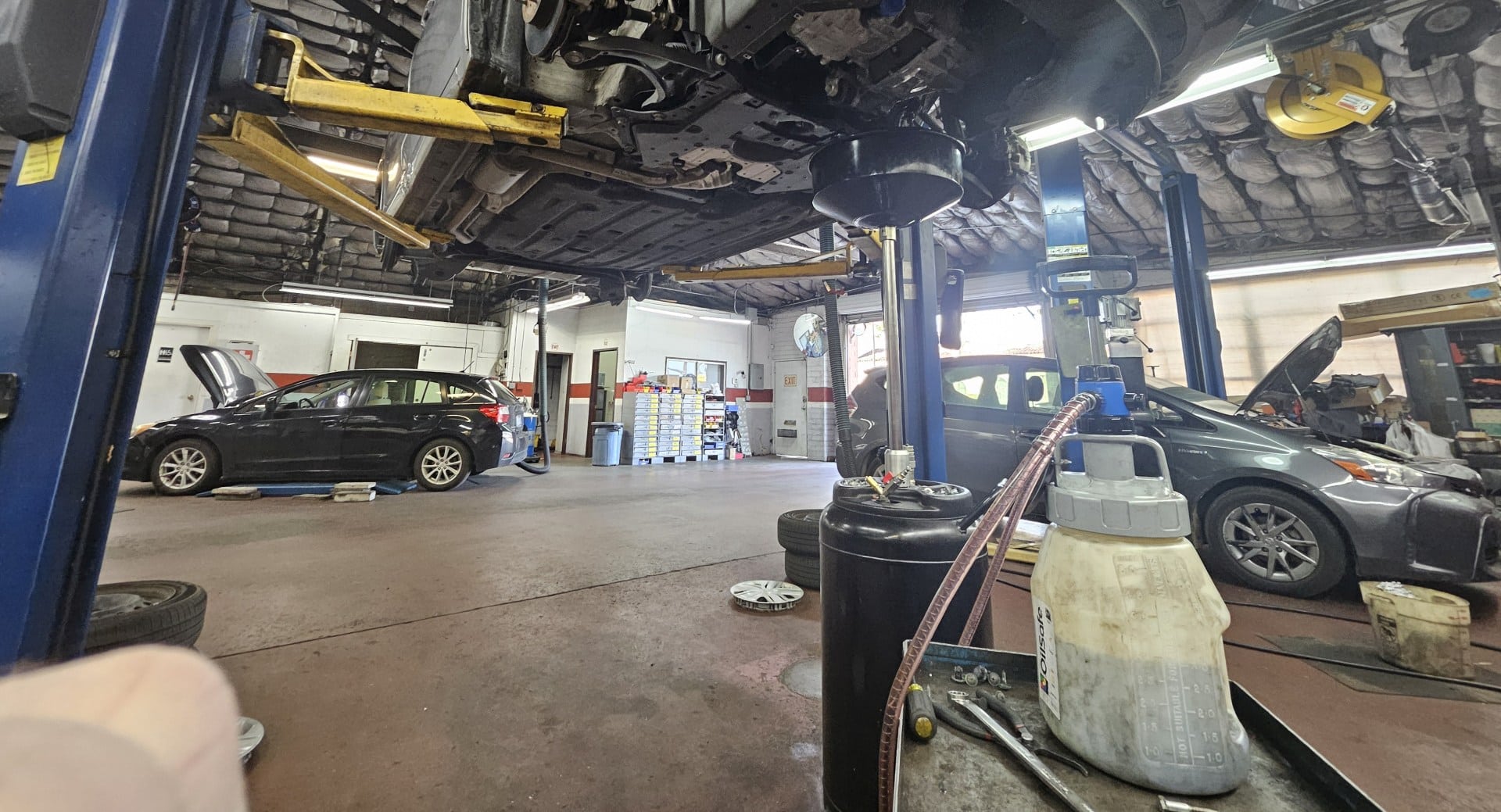You’ll find a lot of different opinions on when transmission fluid should be replaced, ranging from every 30,000 miles to “never”. Transmission fluid, like all automotive fluids degrades over time and absolutely does require periodic replacement. On this page we’ll discuss replacement intervals for different types of transmissions and why you should replace your transmission fluid.
How Often Should Transmission Fluid Be Changed
Don’t feel like reading the whole page and just want an answer? Here’s the quick version. Automatic transmission fluid generally needs to be changed every 30,000 to 60,000 miles, depending on your driving habits and longevity goals for your car. If you use your car or truck for towing, heavy hauling, are frequently stuck in stop-and-go traffic, or frequently “feel the need for speed”, you should probably lean toward a 30,000 mile interval. If you do a lot of freeway driving and the drinks in you cupholder never spill, you’ll probably be fine with a 60,000 mile interval.
Manual Transmission Fluid Replacement
Manual transmission fluid, which is usually gear oil except for a few manufacturers like Honda, also needs to be replaced periodically. Unlike manual transmission fluid, it’s pretty difficult to tell when the fluid has degraded. Typically, manual transmission fluid is checked by removing a fill plug equal to the proper level of the fluid. Fluid we sample the oil by dipping our finger in the fill port. The top of the fluid is typically fairly clean because all of the dirt and debris sink to the bottom of the transmission.
We recommend replacing manual transmission fluid every 30,000 miles. If you’d rather push it further, we’d strongly advise against exceeding 60,000 miles.
Manufacturers Recommendations: Why They Can Be Misleading.
Manufacturer recommendations vary widely, but these days it’s very common for manufacturers to have no published replacement intervals for the transmission fluid. Also, many modern Toyota, Honda, Subaru, and Mazda vehicles have “sealed” transmissions with no dipstick.
Here’s why this is a problem. The manufacturer may say their transmission is “maintenance free”, but it’s simply not true. The transmission fluid will degrade over time and that will cause increased wear to the transmission, eventually leading to an expensive failure.
To make it worse, they’ve made it impossible to quickly check the transmission fluid level. Most modern sealed transmissions require a fair amount of disassembly and scan tool to check the fluid level/condition. Checking the transmission takes nearly as long as replacing the transmission fluid, so it doesn’t really make sense to check the fluid condition periodically like we did in the old days.
We recommend picking an interval based on how you drive and how long you plan to keep the car.
Signs Transmission Fluid Needs Changing
The best way to gauge transmission fluid condition (short of lab testing) is its smell and color. However, as I mentioned above, it’s not so easy to get a sample on many modern cars. Once you’re at the point where you can sample the fluid, it wouldn’t cost much more to replace it.
I see a lot of people on the internet with lists of symptoms that can be caused by degraded transmission fluid. Waiting for a “sign” that your transmission fluid has failed and needs to be changed is a terrible idea.
Replacing transmission fluid is unlikely to solve any transmission symptoms you’re experiencing. In fact, replacing transmission fluid can sometimes make symptoms like slipping and flaring worse. One possible exception to this is juddering. Degraded fluid can cause clutch chatter and replacing it may solve the issue.
Do I Need a Transmission Fluid Change?
Should you replace your transmission fluid? Maybe. Check your records. If it has been more than 60,000 miles since the last fluid replacement, then yes. If you don’t have service records, I’d recommend changing the fluid to build a starting point and then continue on an interval of 30,000 – 60,000 miles.
It’s also worth mentioning that some cars have a transmission fluid life calculation based on driving conditions like RPM, load, number of shifts, etc. Honda has its Maintenance Minder system, which will recommend transmission fluid replacement based on driving history. Toyota has its “ATF Thermal Degradation Estimate” PID in live data. These types of systems will likely become more common as time goes on.
What Happens If You Don’t Change Transmission Fluid?
Neglecting transmission fluid changes can lead to serious issues:
- Increased wear and tear on transmission components
- Potential transmission failure (as in this case of CVT transmission failure)
- Costly repairs or replacement of the transmission
Transmission Fluid Change vs Flush: Pros and Cons
A transmission fluid change involves draining the fluid from the transmission and refilling it with fresh fluid. A transmission flush completely exchanges all old fluid using specialized equipment to pump fresh fluid through the transmission.
When transmission fluid is changed, only about 30% of the fluid is replaced. Not all of the fluid is in the pan. Some is in the torque converter. Some is in the valve body, pistons, and passages.
Unless the transmission fluid has been neglected and is a brown color and smells like burning electrical, changing the transmission fluid is sufficient and less expensive. We’ve done a fair number of transmission fluid flushes, but lately we’ve been recommending against it for several reasons. Here are the pros and cons of flushing transmission fluid.
The Good
- All of the dirty transmission fluid is removed in a single visit
The Bad
- Since most vehicles use specialized transmission fluid, the flush machine must be flushed with the proper fluid before connecting it to the car. Four quarts of $20/qt fluid adds to the expense.
- It requires quite a bit more fluid than the total capacity of the transmission to get the transmission fluid clean. It’s wasteful and more expensive.
- Many modern transmission pipe coolant to a heat exchanger in the transmission instead of piping transmission fluid to a heat exchanger in the radiator. This makes it impossible to use the flush machine since it connects to the cooler hoses.
- Repeated drain and fills do a better job of cleaning the inside of the transmission with less fluid than would be required for a flush.
Our Current Recommendation
If you’ve let your transmission fluid go too long, we recommend changing the transmission fluid every 5,000 miles until it’s clean. You’ll pay for far less fluid and fluid isn’t cheap these days.
Can I Replace My Transmission Fluid Myself?
I’ll never tell a customer they can’t do something themselves. I’ve met some very talented customers over the years, and I’ve seen several tackle projects much more difficult than replacing transmission fluid. However, don’t assume replacing transmission fluid will be easy, even if you’ve done on a different car previously. Modern cars are different.
I’m an expert and I’ve been working in this industry over 35 years so I have a lot of experience. However, I always read the service manual before starting a project. You can’t rely on how it used to be. Things change all the time. Cars are not as simple as they once were.
I always check to see how the fluid level is set, which often requires a scan tool, to see if there are any fluid condition monitors that need to be reset, and most importantly, what type of fluid is required.
So, can you change your own transmission fluid. Probably, if you think you can you probably can, but be sure to read the manual before starting.
Need Your Transmission Fluid Changed? Call for an Appointment!
Would you like us to replace your transmission fluid? Give us a call and make an appointment.
Do you have more questions? We’d be happy to answer. Give us a call.

